The pre-colonial village of Tepoztlan in central Mexico has long attracted visitors drawn to its reputation for mysticism and spirituality.
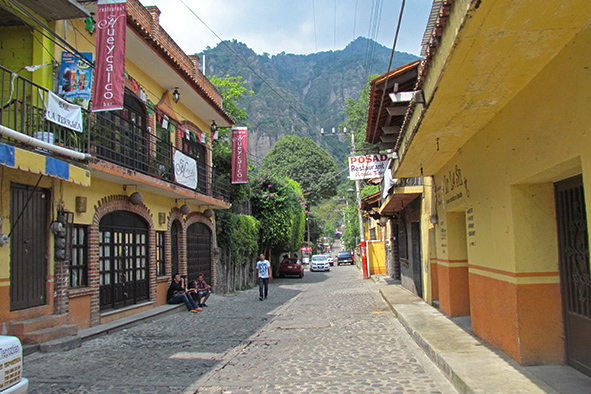
Tepozteco Avenue, Tepoztlan (Photo: Alejandra Alcalde Arreola)
After a childhood spent in a grey London satellite town, I am wide open to the enticements of more exotic climes. Mexico, with its stunning diversity of landscapes, beliefs and traditions, was always going to be somewhere that fired my imagination. Sign me up for mountain shamans, prophetic visions and Aztec serpent gods.
The village of Tepoztlan in central Mexico attracts a steady stream of visitors who are drawn by its reputation for mysticism and spirituality. A healing energy is attributed to the town, owing to the legend that it is the birthplace of the Aztec god Quetzalcoatl. As a result, in recent years, Tepoztlan has attracted followers of a multitude of spiritual practices: from meditation and yoga, to ayahuasca and crystal healing.
Tepoztlan’s geography further adds to its mystery. Its cobbled streets and brightly-colored buildings nestle under a mountain range that soars from the earth majestically.
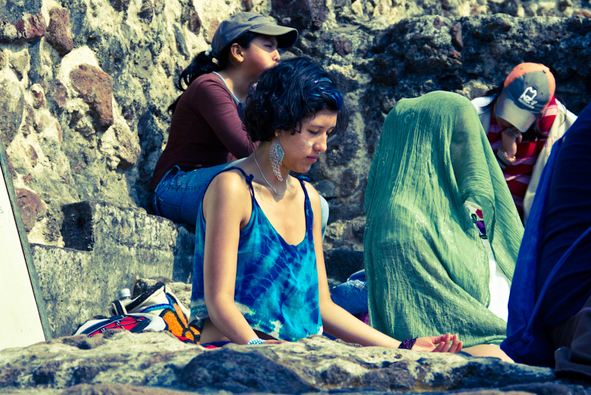
Meditating on Tepozteco Mountain, Tepoztlan (Photo: Sanpani via Flickr)
The Sacred Mountain
After more than an hour tackling a steep stone path and staircase, I finally reach the peak of Tepozteco, the largest mountain in the valley. The ruins of an Aztec pyramid rest like a crown on the summit, while the village loafes loosely across the valley, like a sleeping poet.
This was once the site of a shrine dedicated to Tepoztecatl, the god of drunkenness and fertility; a wild, hedonistic deity with a passion for the bitter beverage pulque. In the fifteenth century, the mountain attracted pilgrims from as far away as Guatemala, until a group of Dominican friars took their hammers to the shrine, leaving only the ruined pyramid.
From the summit, I look down at the lush greens of the valley, while a chirping band of coati wrestle for food scraps among the ruins.
In April of this year, this shaven mountain rock was lit by a great chasm of flame, as the worst fire in the town’s history raged through the mountains. Dozens of frightened families were evacuated as helicopters and firefighters were deployed to fight the blaze. After four days, the fire was finally under control, with officials blaming farmers for the incident.
Locals on the other hand, criticized the government response as slow and badly organized. Groups of volunteers banded together to contain and heal the damage. Firebreaks were made and smoldering flames extinguished.
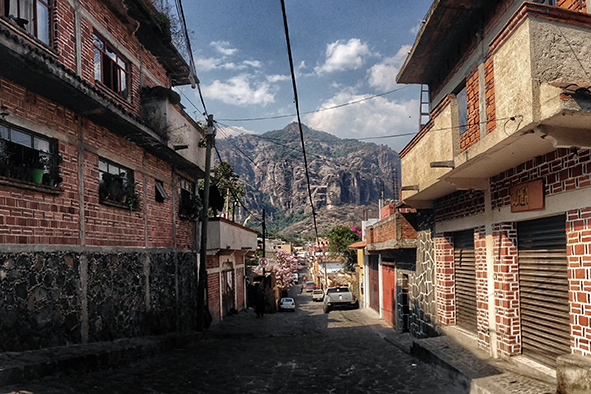
Tepozteco mountain dwarfs Tepoztlan (Photo: Modified from Richard Cawood original via Flickr)
Tepoztlan Against the World
The villagers of Tepoztlan have a lengthy history of standing their ground, and not only when faced with fire. The Spanish conquistador Hernan Cortes ordered the town razed after town leaders refused to meet him. Property developers have also met resistance against repeated attempts to colonize the surrounding hills.
In part, the town mantains its traditional look because chain stores are banned from the area. The nearest Starbucks and KFC are more than 20 kilometers away. Visitors to Tepoztlan won’t even find a branch of the omnipresent Mexican convenience store Oxxo. So instead of Oxxo’s nightmarish inefficiency, tasteless hot dogs and toothpaste-tinted candies, locally-owned shops still flourish in the town. Tepoztlan also has an open-air market which is famous for its pre-colonial dishes. Tlacoyo, a thick tortilla stuffed with beans, is particularly popular.
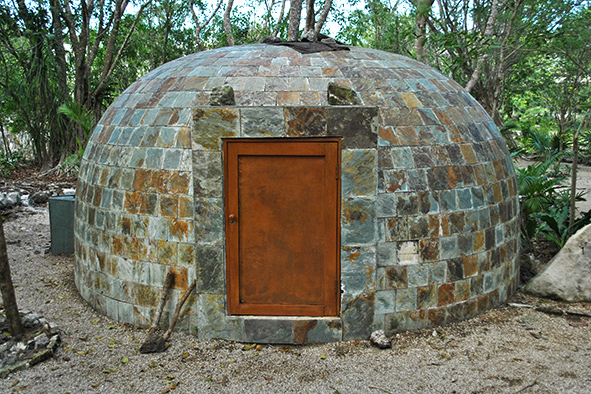
A temazcal (Photo: Amy Maura via Flickr)
The Temazcal
A twenty minute taxi ride from Tepoztlan’s center is the adjacent community of Amatlan de Quetzalcoatl. According to Aztec myth, this was the precise birthplace of Quetzalcoatl, the feathered serpent deity.
I’m here to take part in a sweat lodge ceremony that dates back to the ancient Mayans. A shaman conducts the ritual in an igloo-shaped structure known as a temazcal, or “house of sweat.”
Before entering the temazcal, the shaman asks me to hold my arms away from my body. He takes a chalice filled with burning copal and blows the scented smoke over my face, limbs and torso; a purification ritual designed to rid me of negativities.
I crawl through the arched doorway and sit cross-legged with my back against the wall. The shaman follows me through and takes his place near the center, chanting vigorously in Nahuatl, the language of the Aztecs.
After several minutes, an assistant brings a scorching volcanic rock, known as an abuelita (grandma) through the mouth of the dome on a pitchfork and deposits it in the center. The shaman closes the door behind him. The rock itself does not raise the temperature, but a loud hiss sounds as he pours a bucket of rosemary-scented water onto its surface. Steam dances from the flaming stone and fills the structure. The heat is almost overpowering.
“Relax and focus on your breathing,” the shaman says, “Let the steam embrace you and release your fears.”
The scalding fog engulfs my lungs and burns my ears and nostrils. The shaman chants over a penetrating drumbeat, his voice bouncing from the walls. After a few minutes, he reaches for his bucket and deposits more water on the rock. Just when I think it can’t possibly get any hotter, it does.
The hiss of the rocks fills my ears, and as another searing cloud rises to touch my face, panic sets in. My heart races and I’m gripped by the sudden sense that I’m drowning. For a moment, I think about heading for the exit. But I focus on my breathing. I don’t suffocate. Soon, my heart rate slows, and I am better able to absorb the heavy waves of vapor.
After about an hour in the dome, I crawl out into the bright afternoon.
Have I experienced a purification bringing me to a higher level of consciousness? I wouldn’t go that far. But I certainly feel a sense of personal accomplishment, even invigoration. In the immediate aftermath, my mind is much quieter and I perceive my surroundings with a sharper sense of detail.
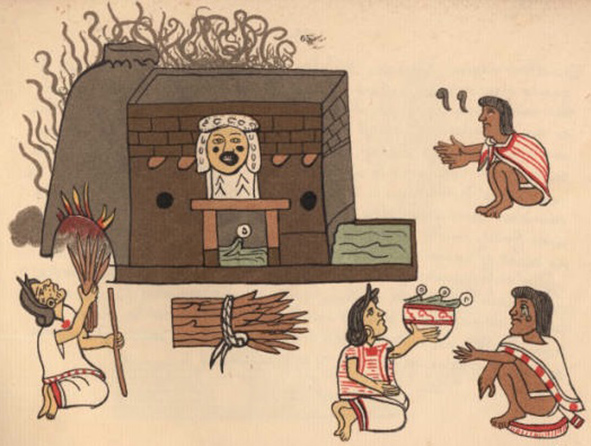
Temazcal depicted in an Aztec codex (Photo: Wikipedia.org)
Shamans for Hire
Ancient Mayans conducted temazcal ceremonies for athletes, soldiers and women in labor, often complementing the experience with hallucinogenics such as peyote or psychedelic mushrooms.
The resurgent popularity of the ritual, especially in pricey spa hotels, has led to charges of cultural appropriation. Critics say ancestral indigenous practices should not to be used to make a fast buck.
“Temazcals in spa hotels are nothing more than exotic baths for tourists,” says David Cordova, a Mexican photographer who has visited Tepoztlan a total of five times. “True temazcals are about self-discovery and therapy.”
Cordova believes it is inappropriate to run the ritual for profit and any fees should be nominal and voluntary.
Yet Greg Roach, the founder of Spirit Quest, which organizes tours to Tepoztlan, welcomes the opportunity to work with local indigenous communities.
“The temazcals I’ve participated in have always been led by a local shaman, and the support staff and helpers are all from the local communities,” Roach says. “Aside from the obvious financial benefits, this helps keep the traditions alive and vitalized. It also brings a beautiful, powerful and important spiritual practice to a much wider audience.”